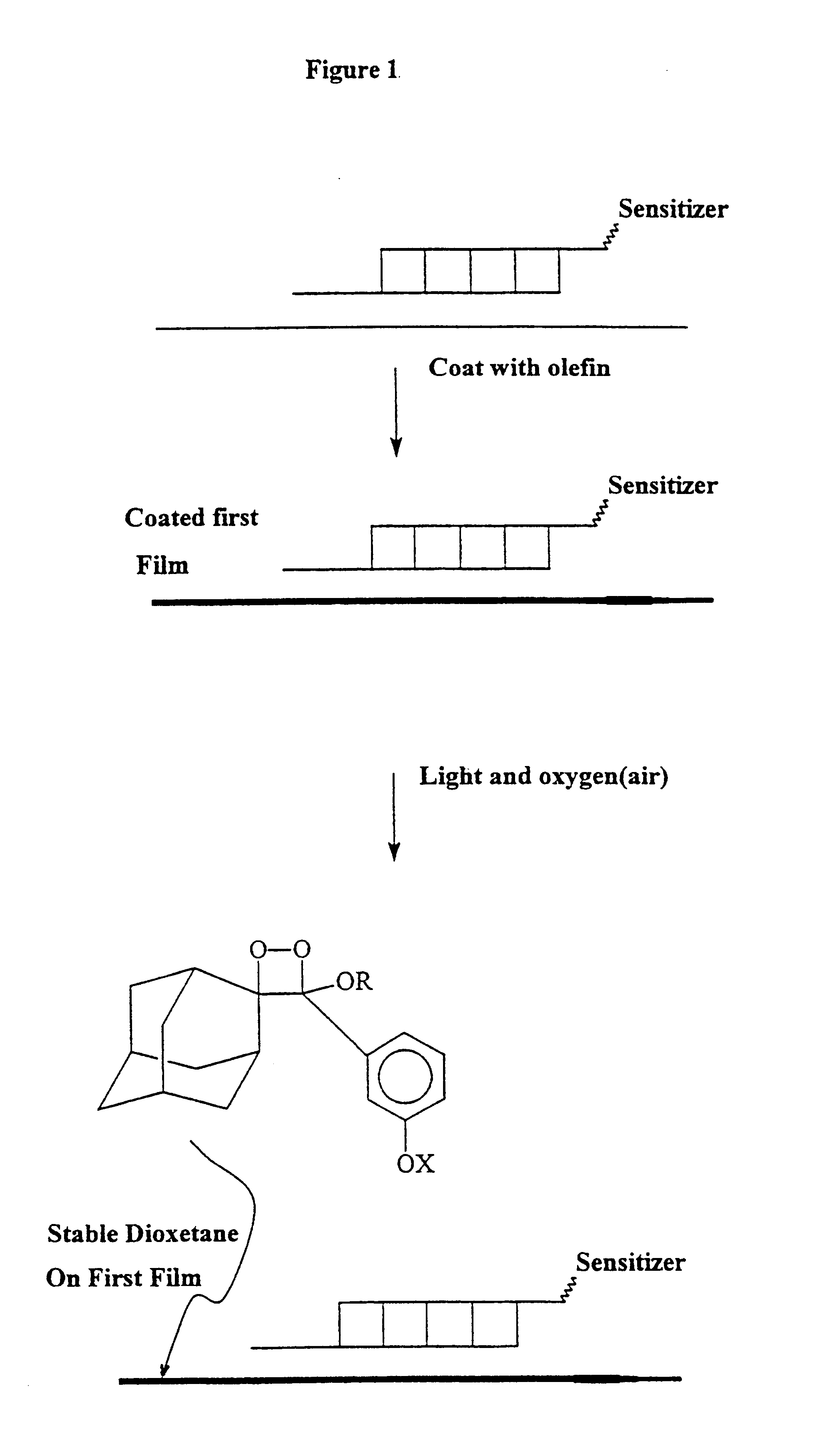Activating film for chemiluminescent assays and methods for use
a technology of activating film and chemiluminescent assay, which is applied in the direction of material testing goods, analysis by subjecting materials to chemical reactions, instruments, etc., can solve the problems of increasing the number of reagents, many steps, and requiring more time to complete the assay
- Summary
- Abstract
- Description
- Claims
- Application Information
AI Technical Summary
Problems solved by technology
Method used
Image
Examples
example 1
Sensitizer Labeling of Oligonucleotide
Modified methylene blue derivatives were obtained according to procedures described by Motsenbocker, et al. The terminal carboxy group of an activated N-hydroxysuccinimido ester form of the methylene blue sensitizer was coupled to a 5'-aminomodified oligonucleotide using standard methods known in the art. (Ruth, J. L., in Oligonucleotides and Analogues: A Practical Approach, Eckstein (Editor), pp. 255-280, Oxford University Press, NY 1991). The oligonucleotide was complementary in sequence to cDNA encoding alcohol dehydrogenase. The 5'-aminomodified oligonucleotides used for labeling with methylene blue as well as unmodified oligonucleotides used for PCR amplification of the target alcohol dehydrogenase cDNA were synthesized on a PE Biosystems Nucleic Acid Synthesizer, Model No. ABI 3948.
example 2
Dot Blot Hybridization of Methylene Blue-labeled Oligonucleotide to Target DNA
Following PCR amplification of the target DNA, said DNA was spotted on a Hybond+ nylon membrane (Amersham-Pharmacia), along with negative controls of linearized pUC19 DNA at various concentrations ranging from 25 to 500 fmoles in a total volume of 1 microliter. Spots were allowed to dry. The DNA was subsequently denatured and fixed as follows: 1 minute soak in 1.5 M NaCl; 0.5 M NaOH, followed by fixation by baking at 120.degree. C. for 40 minutes, followed by 5 minute soak in 1.5 M NaCl; 0.5 M Tris-Cl pH 7.5. Hybridization was as follows: The filter membrane was soaked in prehybridization buffer (0.25 M Na--PO.sub.4 ; pH 7.2; 7% (w / v) SDS for 45 minutes at 40.degree. C. in a total volume of 0.5 ml per cm.sup.2 membrane. The labeled oligonucleotide probe was added directly to the prehybridization buffer at a final concentration of about 2 umoles / ml and incubated for 16 h at 40.degree. C. The hybridized memb...
example 3
Method of Detecting Target DNA Hybridized to Methylene Blue-labeled Oligonucleotide
Hybridization was detected by first briefly (less than 5 seconds) dipping the hybridized membrane in an olefin solution (1 / 100% w / v in hexane or methanol), wherein olefin was synthesized by the method of Schaap as described in U.S. Pat. No. 4,857,652, and allowing it to air dry, then illuminating the hybridized surface with red light for 15 minutes. In order to detect the signal, a sheet of filter paper previously soaked in a saturated solution of ammonium carbonate and then dried to a solid form was taped to a glass plate. The hybridized membrane with bound target DNA was subsequently placed (DNA side up) on top of the filter paper containing the dried base and a sheet of plastic was placed on top of this. In the dark, a sheet of Hyperfilm ECL (Amersham-Pharmacia) was placed over the plastic sheet and another glass plate was placed on top. The whole sandwich formation was incubated at 80.degree. C. f...
PUM
 Login to View More
Login to View More Abstract
Description
Claims
Application Information
 Login to View More
Login to View More - R&D
- Intellectual Property
- Life Sciences
- Materials
- Tech Scout
- Unparalleled Data Quality
- Higher Quality Content
- 60% Fewer Hallucinations
Browse by: Latest US Patents, China's latest patents, Technical Efficacy Thesaurus, Application Domain, Technology Topic, Popular Technical Reports.
© 2025 PatSnap. All rights reserved.Legal|Privacy policy|Modern Slavery Act Transparency Statement|Sitemap|About US| Contact US: help@patsnap.com



